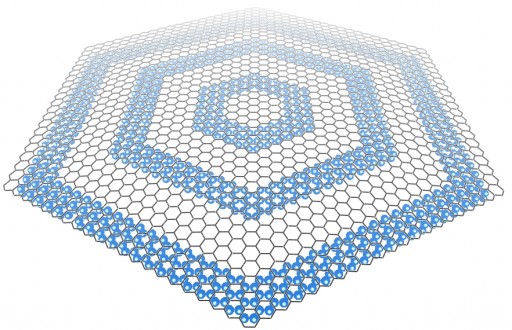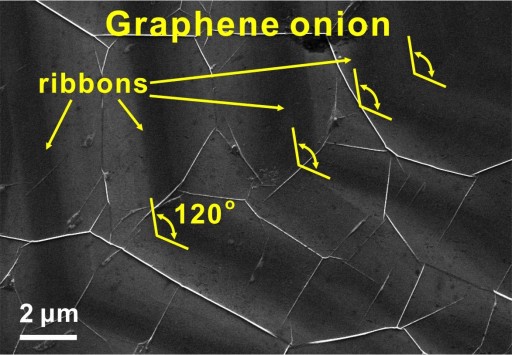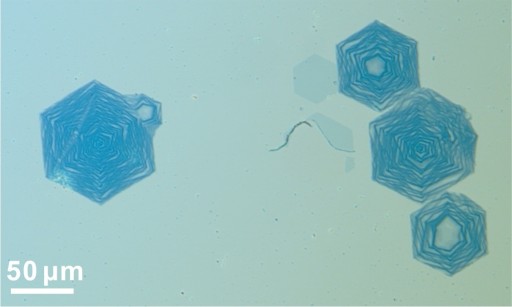Graphene ‘onion rings’ grown bottom up — atom by atom
July 22, 2013

Structural models of hexagonal graphene “onion rings” show a layer of graphene, a single-atom-thick sheet of carbon, atop a set of concentric nanoribbons. The ribbons grow by chemical vapor deposition in a high-pressure, hydrogen-rich atmosphere. (Credit: Yuanyue Liu/Rice University)
A Rice University lab has grown ‘bottom-up’ graphene nanoribbons for the first time.
These concentric hexagons, grown in a furnace, represent the first time anyone has synthesized graphene nanoribbons on metal from the bottom up — atom by atom.
As seen under a microscope, the layers brought onions to mind, said Rice chemist James Tour, until a colleague suggested flat graphene could never be like an onion.
“So I said, ‘OK, these are onion rings,’” Tour quipped.
The name stuck, and the challenge was to figure out how such a thing could grow, Tour said.
Usually, graphene grown in a hot furnace by chemical vapor deposition starts on a seed — a speck of dust or a bump on a copper or other metallic surface. One carbon atom latches onto the seed in a process called nucleation and others follow to form the familiar chicken-wire grid.

An electron microscope image of graphene “onion rings” shows the concentric, dark ribbons through the overlying sheet of graphene. The ribbons follow the form of the growing graphene sheet, which takes the shape of a hexagon. (Credit: Tour Group/Rice University)
Experiments in Tour’s lab to see how graphene grows under high pressure and in a hydrogen-rich environment produced the first rings.
Under those conditions, Tour, Rice theoretical physicist Boris Yakobson and their teams found that the entire edge of a fast-growing sheet of graphene becomes a nucleation site when hydrogenated. The edge lets carbon atoms get under the graphene skin, where they start a new sheet.
Potential for low-voltage transistors, lithium batteries
“The big news here,” Tour said, “is that we can change relative pressures of the growth environment of hydrogen versus carbon and get entirely new structures. This is dramatically different from regular graphene.”
The width of the rings, which ranged from 10 to 450 nanometers, also affects their electronic properties, so finding a way to control it will be one focus of continued research, Tour said.
“If we can consistently make 10-nanometer ribbons, we can begin to gate them and turn them into low-voltage transistors,” he said. (Low-voltage transistors have reduced power requirement, and thus lower heat, so size can be reduced.) They may also be suitable for lithium storage for advanced lithium ion batteries, he said.

This set of hexagonal graphene “onion rings” was grown at Rice University. The rings represent the first example of graphene nanoribbons grown from the bottom up — that is, atom by atom — via chemical vapor deposition. (Credit: Tour Group/Rice University)
Tour is the T.T. and W.F. Chao Chair in Chemistry as well as a professor of mechanical engineering and materials science and of computer science at Rice.
Yakobson is the Karl F. Hasselmann Professor of Mechanical Engineering and Materials Science and professor of chemistry.
The Singapore National Research Foundation, the Office of Naval Research, the Lockheed Martin LANCER IV program and the Air Force Office of Scientific Research supported the work.
Calculations were performed on the National Science Foundation-supported DaVinCI supercomputer at Rice, the National Institute for Computational Sciences’ Kraken and the National Energy Research Scientific Computing Center’s Hopper.